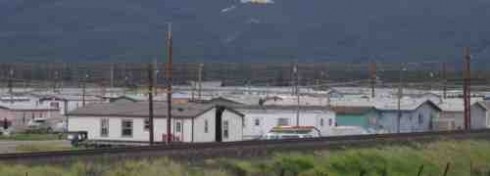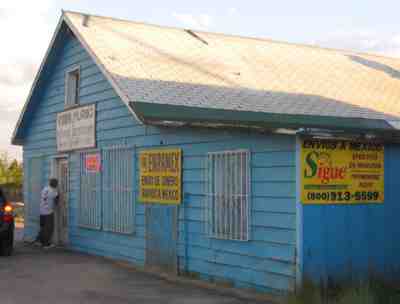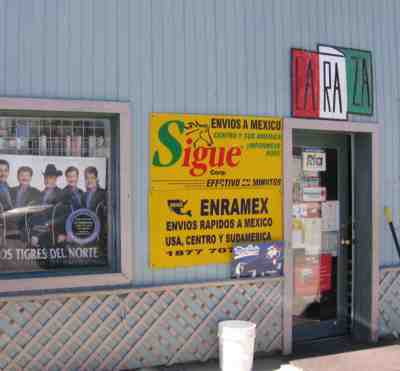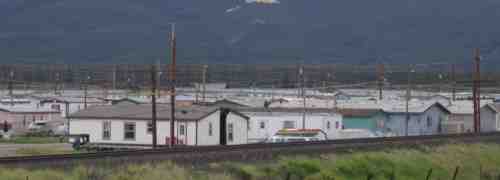Article by Nancy Hiemstra
Immigration – September 2006 – Colorado Central Magazine
AS THOUSANDS OF TOURISTS drive through Leadville every year, they likely remember it as an Old West mining town. They pass signs inviting them to visit local museums, take a train ride, and walk on the Mineral Belt Trail. Some might notice there are several stores with Spanish names, and fewer still will observe that the trailer parks outside of town are mainly populated by Latinos.
The mining-town flavor of Leadville began changing quickly with the closing of the Climax Molybdenum Mine in the early 1980s and the subsequent departure of many miners and their families. Leadville then transitioned to a bedroom community as many remaining former miners began commuting out-of-county for work.

It was around that time that nearby Eagle and Summit County ski resorts expanded quickly, along with associated support businesses and general services. Soon the need for construction workers, housekeepers, maintenance personnel, and various low-wage employees was beyond what the existing local population could provide. To fill vacant jobs employers turned to Latino immigrants, eager to come for such work from other U.S. states, Mexico, and Central America. However, with the surging cost of housing in those resort counties, Lake County became a popular alternative for the new arrivals.
Leadville is a small town, with a limited number of stores, offices, and public places. However, when a variety of residents were asked where the most contact with the “other” group occurs, their answers revealed that interactions between native-born and immigrant residents are actually few and far between. The response of a Mexican woman was very telling, “Almost never…When I go shopping, that’s the only time I talk to them.”
This separation isn’t, for the most part, due to attitudes of resentment by native-born residents. When a city official was asked to estimate what percent of long-term residents felt negatively toward Mexican immigrants, he replied, ” I won’t put a number on it, but I think it’s fairly small. I think it’s also fairly small the number that are concerned about treating them well. Most people are just not concerned…Primarily because they don’t have any contact with them.” So, despite the relatively even numbers of immigrants and non-immigrants, native-born residents and Mexican immigrants have separate communities, and as yet they haven’t blended to any real extent.

While it’s not all that surprising that drive-through tourists don’t pick up on the new Latino population, it is remarkable that native-born residents who live there don’t know that much more about the substantial immigrant population, either. How is this possible, that a county as small as Lake, and with Leadville as the only town to boot, can be home for two distinct groups that seldom interact?
THE MOST OBVIOUS REASON for this separation is the high level of commuting among Latino immigrant residents. They come to the region to work, and most of their work is a forty- to ninety-minute drive away. While a lot of Lake County residents commute out of county (52%, according to the 2000 Census), a much higher percentage of Latino workers than white workers commute (70% of the Hispanic/Latino population, 48% of the white population). What’s more, immigrants typically work more hours than native-born residents, either through overtime or by holding more than one job. In the winter, some commuters will go days without seeing Lake County in the daylight. Martín, a local Latino leader, pointed out, “[Immigrants] don’t work here in Leadville. They work in Vail, in Eagle, Gypsum. In short, in other places. So, people leave early, and get home late. Especially women, they come home to cook, bathe the kids, and then sleep…. And the next morning, once again they get up early.” A lot of immigrants simply don’t have time or energy to invest in local activities.
Another separating influence is the fact that most Latino immigrants in Lake County live in trailer parks, which tend to be several miles outside of town. Drawn to the region by low-wage employment, they don’t have the resources to buy a house in town. Bonita, a stay-at-home mom, confessed, “I don’t like my home, because, as it’s a trailer, the air comes in everywhere!” However, she explained, “We don’t have the money to buy a house. And bank financing is so expensive, and we don’t have enough. The truck is financed … and having small children costs so much.” For those immigrant workers who want to invest in a home, trailers are comparably easy to get into — purchase can be arranged directly from the park owner, avoiding the hassle of bank financing.
MARTÍN ALLUDED TO another issue: he moved his family into a rental house in the West Park neighborhood, and he immediately sensed unwelcome eyes staring at him through shuttered windows. He reflected, “It does make me a little sad, to know that everyone who lives around me is native-born, and native to Leadville, and that they were unhappy [that we live here]. Even today, some people still don’t talk to me.” Tales of such experiences are shared with other immigrants, discouraging them from living in town. Mobile home parks become a place where Latinos can relax, and not worry what the neighbor is thinking.
Immigrant and native-born residents also don’t have equal ease of access to places in Leadville. First of all, the distance of most trailer parks from town comes into play. There is no public transportation in Lake County (except for resort-county buses that take employees back and forth to work). There aren’t sidewalks along the highways from the trailer parks into town, and road shoulders are piled high with plowed snow for a good portion of the year. Also, a lot of immigrant families have just one car, so when one spouse takes the vehicle to work, the spouse who stays home, often with children, is stuck there, unable to take advantage of activities that may be going on in town. Millie, who works with a social service agency, explained how hard it can be for immigrant mothers to get into town and commented, “I think they’re pretty isolated out there. And if their husbands don’t bring them, sometimes they don’t get out.”

Furthermore, because of commuting and the distance of their trailers from town, immigrants often go into public places in Leadville at different times than native-born residents. For example, if you go to Safeway in the middle of the day, there are typically more native-born than Latino shoppers, but if you go after 8 pm, more Spanish than English is spoken.
Less tangible factors also play a role in separating immigrant and native-born residents. Not knowing how local systems work is intimidating and frightening for the former, and explaining how they work can be exasperating for the latter. Residents trying to communicate may have to stretch far out of their comfort zones.
Martín told of being invited to a meeting as a liaison to the Latino community. He recalled, “They asked me this question: ‘Why are the Mexicans arrogant, conceited, don’t talk [to us]?'” He replied to them, “Why? Because they don’t know the language! They’re afraid to talk.”
Everyone, native-born and immigrant alike, may feel frustrated and anxious when they don’t understand what is being spoken around them. Bonita related, “I remember when I first arrived, my husband sent me to the store alone. I didn’t want to go because the clerks didn’t speak Spanish, and I got so nervous that my knees were shaking.”
Most immigrants desperately want to learn English. Juanita, who works in food service in Summit County, recognized that, among other reasons, there are few opportunities for job advancement without knowing the language. She said, “As for me, I tell you, I really need to learn English. Because, with English, I could get a better job, meet more people, and they would help me and I’d help other people. But I don’t know English, and that’s my problem.”
Colorado Mountain College, together with the public school district, has been offering free English classes for the past three years, and the classes have been very popular. However, the long work hours and commute leave some potential students too exhausted. Daniela, a naturalized immigrant now working with the immigrant community, explained, “Even though they wish to take classes, they can’t because of their work. And others…they spend so much time away from their family already, then having to come home and go somewhere else, it’s so hard.”

The undocumented status of many Latinos is perhaps the most powerful factor separating them from native-born residents. Because immigrants without papers usually prefer to remain under the radar, so to speak, it’s hard to know exactly how many there are in Lake County. It suffices to say that probably every Mexican at least knows someone, be it themselves, a family member, or a friend, who lives in a legal limbo.
The fear of financial penalties, imprisonment, and the forced separation of families and friends through deportation constantly hangs over the immigrant community. An incident in May of 2004 captures this dynamic: the county sheriff’s office, in cooperation with several federal and state agencies, arrested a number of Mexican nationals in one of the trailer parks as part of an undercover narcotics operation. Though the operation only targeted those involved with the drug trade, undocumented immigrants throughout the county were terrified. Many went to stay with relatives outside the county, or didn’t leave their homes. A local law enforcement officer recounted, “You know, in Safeway, there was not one Mexican in there. You’d go places, they weren’t around …. A lady called, I felt sorry for her, she said, ‘Are they going to pick us up? My baby’s been out of milk since yesterday, and I’m scared to go to the store.’… I’m not kidding you, for two days, they disappeared.”
Such fear permeates the lives of undocumented immigrants, shaping the ways in which they engage in the larger community. María, who came to Leadville four years ago, relayed her experiences when she first arrived in Lake County, “I tell you that at the beginning, I didn’t go out, because I said, ‘it isn’t my place, it isn’t my people, I am here without permission.’ It felt like it said here on my forehead ‘illegal.’ So, I was very afraid to go out.”

UNDOCUMENTED IMMIGRANTS also hesitate to do anything that would make them more known, and therefore vulnerable. Several interviewees said they “go over the hill” to shop for groceries in Summit County because they feel more anonymous in the large stores. Finally, the no-man’s-land of living without papers entails a sense of uncertainty about the future, which adds to reluctance to get involved.
Many Mexican residents expressed bewilderment and even frustration at their legal situation. Most immigrants don’t feel like they had much of a choice in coming to the United States. The economic situation in Latin America has spiraled out of control in the last twenty years, aggravated by U.S.-led trade deals that weakened local farming and manufacturing. And though there are many employers eager to hire them in the resort counties, they still feel like they should keep a low profile. Dora, a hotel housekeeper, commented, “You come to work, for a better life…You don’t come to commit crimes, like robbery and other things. You come only with the goal of working. And when you hear, ‘La Migra!’ (slang for the U.S.’s immigration law enforcement agency) it makes you afraid.”
Undocumented legal status also makes immigrants susceptible to employer abuses. A Latino construction worker related, “[The employers] hire an illegal person, most often in construction. ‘Yes, I need you, come to work this very day,’ and he works one or two weeks, and on pay day, ‘Give me your social security number or I’m not going to give you your check.’ And they don’t give them anything.” Most employers don’t operate like that, but when such things occur, an undocumented immigrant can do nothing.
![Spanish-speaking church services on Harrison Avenue] Spanish-speaking church services on Harrison Avenue]](https://coloradocentralmagazine.com/wp-content/uploads/2009/12/01510211.jpg)
Almost every immigrant interviewee listed not being able to get a U.S. driver’s license, and therefore insurance, as one of the top problems for undocumented residents. Being unable to legally drive to their place of work puts them in an impossible situation. Daniela explained, “You know, they can’t get a driver’s license, and they have to drive, they have to go to work….And eventually they get in trouble, and its not like it’s something they want to do but they have to do it because you’ve got to work in order to feed your family.” All of these factors tied to being undocumented complicate some immigrants’ daily lives, and shape how these immigrants and native-born residents interact.
Leadville was built over a hundred years ago by immigrants from all over Europe. Today, however, there are no mines to act as an eventual equalizer, and new immigrants face legal and economic barriers that earlier immigrants did not. It’s too early to say how Colorado’s new hard-line laws, along with the current heated national debates on immigration and border security, will affect Lake County’s newest immigrants. When a Mexican resident was asked whether the new laws made him want to go back to Mexico, he shook his head. “In one day here, I earn what I make in one month there. My family would starve — I can’t go back.” It seems that, like a century ago, today’s immigrants will become tomorrow’s Americans. The question is, will towns like Leadville be home to one cohesive community, or two separate ones?
There are many hopeful signs that Leadville will figure out how to be a welcoming place for all of its residents. María, who was afraid to go out when she first arrived, is now almost fluent in English, and frequently volunteers in her children’s classrooms at school. Martín has now bought a house in town in a neighborhood in which he feels welcome. Community change, after all, must happen locally. A woman who works for a local non-profit organization noted, “I do feel in the few years that there is a different level of readiness to embrace our new population of people.” A number of organizations are actively involving Latino immigrants and their children in the larger community (see sidebar on Leadville’s Immigrant Integration Initiative). The public schools are gradually focusing on outreach to immigrant parents who may be unfamiliar with local education system expectations. An adult indoor soccer league formed two years ago, and over half of the participants are Latino. Greater inclusion may simply be a matter of time and attention, and the longer that Latino immigrants and native-born residents share the town, the more they will build common ground. ¤



